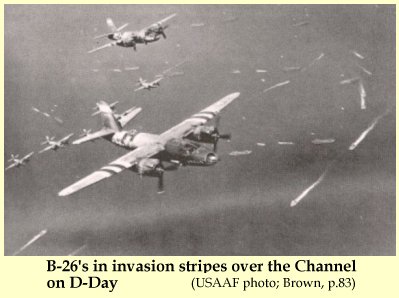
 |
Journal Entries:April – September, 1944 |
April 23
Still putting off writing about my last leg of the trans-Atlantic flight. [1] Today I was on my thirty-ninth mission. It was my first in over a month and also my first with the 397th Group. I rode as second Navigator leading the second box. Major Berkencamp of the 599th (C.O.). The target was a no ball in the Hesdin Forrest area. Light flak was encountered but the trip was without incident. It was a rare and beautiful day in the E.T.O.
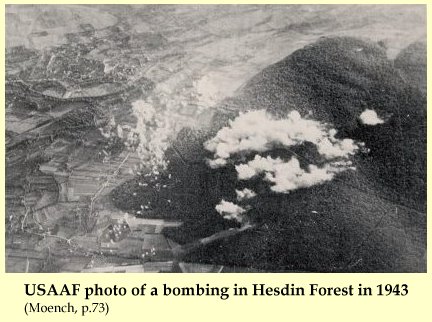
Whitie Sterngold, Capt. and crew who I flew one mission with in the 391st, will leave for the states in the morning on a good will tour. It is to be for sixty days.
May 11, '44 - England
On April 28, I was on #40. I rode as bombardier with Lt. Kretschmer of the 599th Sqdn. We were to bomb the railroad yards at Mantes, France, a town of good size on the Seine River. We flew in over ten-tenths and we stayed on top the whole time. It was a long and extremely tiring ride with no incidents and of course we did not drop our bombs. Poix Airdrome was our secondary target and that, too, was covered over with a thin blanket of cloud.
On May 2, I passed on the road to fifty (not that it means a whole lot) by running #41. I was acting as bombardier for my old crew (Capt. Enderton). We hit the yards at a small town near Le Cateau, France about fifteen miles southeast of Cambrai. The trip was what one would call an ideal trip. It was a deep penetration and it was a beautiful day in France that day. I amused myself by finding interesting spots along the course and pointing them out to the Beast (co-pilot John King, Wis.) who was about to pass out for lack of oxygen. We were cruising at an altitude of 12,500' most of the way. San Quentin, Brussels, and Ghent were some of the high points along the route.
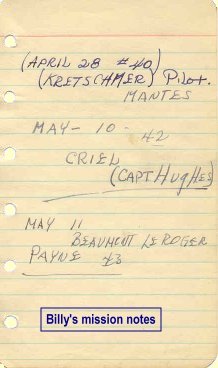 On May 10, I was scheduled with Capt. Hughes (Assistant Operations Officer 397th Group). We were on a wing and I was bombardier again. We hit the yards at Criel near Paris. It was my second trip to the target. The weather was bad over the channel and I thought for awhile that we would be forced to turn around but it cleared as we went deep into France. As we reached the I.P. and turned on to the target I saw the city of Paris for the second time. This time I saw a little more of it. It is spread far and wide with the Seine running through the center of town. We bombed our target in flights of six and our six missed. We were following thirty-six ships of the 387th Group and they did hit the target and started fires in the yards. To go back a moment, on the way in I saw an enemy fighter go down near Amiens Glisy airdrome. He was brought down by our spit escort and he went down in flames. On the way out we ran into a small barrage of very accurate flak near Grandvillers. No one was hit seriously, however.
On May 10, I was scheduled with Capt. Hughes (Assistant Operations Officer 397th Group). We were on a wing and I was bombardier again. We hit the yards at Criel near Paris. It was my second trip to the target. The weather was bad over the channel and I thought for awhile that we would be forced to turn around but it cleared as we went deep into France. As we reached the I.P. and turned on to the target I saw the city of Paris for the second time. This time I saw a little more of it. It is spread far and wide with the Seine running through the center of town. We bombed our target in flights of six and our six missed. We were following thirty-six ships of the 387th Group and they did hit the target and started fires in the yards. To go back a moment, on the way in I saw an enemy fighter go down near Amiens Glisy airdrome. He was brought down by our spit escort and he went down in flames. On the way out we ran into a small barrage of very accurate flak near Grandvillers. No one was hit seriously, however.
This brings me up to date and today's raid marked #43 for me and it was an old target—Beaumont Le Roger airdrome. The trip was carried out successfully even though navigation was a bit difficult due to a thick haze. We hit the target. Our escort was a single squadron of P-38's, the prettiest airplane ever built. Payne, of Atlanta, Ga., was my pilot today.
May 17 — England
On May 15 I made #44. I was Bombardier on the McCarthy-Louden. Lt. McCarthy and Louden were, or I should say, are two Lts. Of the 599th Sqdn. Our Target was an airdrome at Valenciennes, France. We followed the 323rd in to the target and the whole formation of seventy-two ships was escorted by P-38's. The trip was without incident as we were on top nearly all the way and we couldn't even see the target. We were off course somewhat on the way out. I got to see Ghent which was the target of my first raid on Sept. 5th of last year. It was a long tiring ride that brought us no closer to the end of the war.
July 20 — England
I awoke this Thursday morning in my new quarters at Beaulieu airdrome in the south of England . Summer has indeed arrived in this part of the country. Things have happened as things will do since my last entry on May 17. Chuck and Mac are gone. Mart Bischoff has also returned to the zone of the interior. I have assumed the duties of Squadron Navigator of the 455th Sqdn, 323rd Bombardment Group. In the past two months I have advanced in combat experiences from 44 to 60. On May 24 I along with Chuck and Mac [2] and the rest of the crew of the old "Bird Dog Special," were still with the 397th Group of Colonel Coiner. On this day I rode as Gee operator with Captain (now Major) "Ham" Hamilton operations Officer of 599th Sqdn. We attacked a military objective in the Harbour of Dieppe. The name Dieppe always strikes terror in the hearts of airmen as it must in the hearts of those Rangers and Commandos who made the night raid on the city some few years ago. We attacked from the sea without loss however.
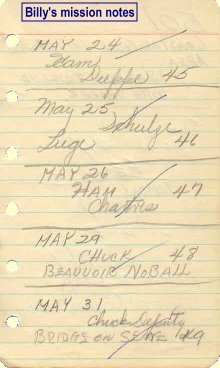 The following day, May 25, I made my 46th raid with a new replacement crew whose skipper was a boy named Schulze. Our target was a railroad bridge at Liege. We were in a wing slot and the mission, though opposed by flak, was carried out without loss. I had a good look at Belgium that day thru the nose of a Marauder.
The following day, May 25, I made my 46th raid with a new replacement crew whose skipper was a boy named Schulze. Our target was a railroad bridge at Liege. We were in a wing slot and the mission, though opposed by flak, was carried out without loss. I had a good look at Belgium that day thru the nose of a Marauder.
On May 26th I was with Ham again leading six. We attacked an airdrome near Chartres, France. I was on the Gee set
 again. When operating Gee one seldom sees much of the fight.
again. When operating Gee one seldom sees much of the fight.
Now on the 27th of May we were on the move again, transferring back to the white-tailed Marauders of Wood's 323rd. Going back to the old group was like going home. The old faces were welcome sights to our eyes.
Of course Mick was there and Mart Bischoff and all the old F.C. with the exception of Bob Felt who went down over Liege along with one of his Wingmen. We moved in and went to work, but quick.
As Mac and I suspected our first target was a Lulu. We were to lead the second box into the Pas De Calais area and hit a noball near Frévent, France. Now Frévent is a target that is always associated with intense flak barrages and flamers. Mims & Bryan went down there. Druhl, Kaiser & Bischoff had their plane damaged so badly at the target that they were forced to bail over the channel. But as it sometimes happens on an expected rough target the Germans just didn't have us and we escaped with very little damage. This was no. 48 for me.
July 21, 10:15 A.M.
Our planes are circling the field now after their trip from Earls Colne.
To continue with my account of the raids: on May 31, I made my 49th sweep over the channel. I was with Chuck again, flying
 deputy to Sloane Box II. We attacked a bridge on the Seine River. We were all under the impression at this time that we were destroying bridges along the Seine to keep Hitler from moving troops into the north of France. We flew through heavy cloud formations at landfall and proceeded to bomb our objective. Lt. Keister of Fort Wayne was bombing for Sloane and did a beautiful job.
deputy to Sloane Box II. We attacked a bridge on the Seine River. We were all under the impression at this time that we were destroying bridges along the Seine to keep Hitler from moving troops into the north of France. We flew through heavy cloud formations at landfall and proceeded to bomb our objective. Lt. Keister of Fort Wayne was bombing for Sloane and did a beautiful job.
It was on June 2nd that I was called on to fly with Capt. Sparks of the 453rd Sqdn. I had known Sparky for some time since he had served on D.S. with our bunch in the 391st and 397th . On this day I made no. 50, or I made the hump. We were leading the third box of twelve ships and we attacked a coastal gun in the Le Havre area. No incidents.
June 4th, mission #51 with Chuck again. Target: coastal gun near Fécamp, leading eighteen. We hit short of the target; encountered no opposition. All missions prior to my 52nd, on June 6, 1944, were made with the one to be run in mind. One year of fighting with one raid in mind and that was the one that would be in direct support of the Invasion of Europe.
The two days of June 5th and 6th will live in my memory forever. June 5th started like any other day in the E.T.O. Our crew
 was not on the loading list and when a meeting was called for all lead teams to meet with the Colonel—Colonel Lewis, Wing C.O. along with Wilson Wood, our own C.O.—Lewis made a small speech in the situation room in which he praised our work in the months past and said our work had been important but
was not on the loading list and when a meeting was called for all lead teams to meet with the Colonel—Colonel Lewis, Wing C.O. along with Wilson Wood, our own C.O.—Lewis made a small speech in the situation room in which he praised our work in the months past and said our work had been important but
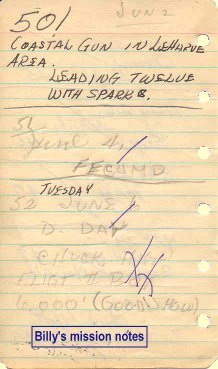 that our job from now on was to be of still greater importance. He said that the much talked about and expected D.Day was surely at hand and that he was sure that we would carry out our particular job as well as we carried out the operations during the year prior to this all important Day.
that our job from now on was to be of still greater importance. He said that the much talked about and expected D.Day was surely at hand and that he was sure that we would carry out our particular job as well as we carried out the operations during the year prior to this all important Day.
Colonel Wood took the floor when Lewis had gone and read to us the loading list that would be in effect that morning when our boys were to storm the beaches of ?.... yes, where would they go in? I made a quick bet with Chuck that it would be the Lowlands. It was a four pound bet (he owed me the four). And I lost it some five minutes later when we were actually given our targets for D.Day. I'm getting ahead of my story, though; to get back to Colonel Wood's first speech in the situation room. He said that this was to be the greatest operation in all of military history and that we were going to make history that day (of course that this was to be the greatest of all military events since the beginning of mankind was known by all of us but it gave you a strange feeling deep inside to hear someone say it). The Colonel also tried to impress upon us the importance of our mission and said if we ever hit a target that that would be the time and place to do just that. He told us that the targets we were to be briefed on while we were still there in the building were to be secret and he cited what would surely happen to any one who divulged any information whatsoever about what we heard the afternoon of that day. He said that we would be billeted [3] from that day until we ran the mission on D.Day. Now when he said that it was the clue we needed to decide when D.Day would be. In that room were all the lead teams of the group: it would have been impossible to have run a mission without using some of those teams. We knew that the mission that the 323rd Group ran would be on D.Day.
(One thing I forgot to say that was included in the address by Lewis. He said that our C in C General Eisenhower and his aides had studied this great undertaking and ruled out every single plan, or operation, that even smelt of failure. We plan it for complete victory, he said.)
From the situation room we went into a room in the very back of Group Operations and there were our targets and maps of the proposed beachhead on the walls and we knew that in a few days a word, a name of a small port in France would be a word shouted around the world: " Cherbourg "[4]
July 22, '44
We received our target pictures. Mac and I studied ours very carefully; this was one target we must hit the first time. It would be
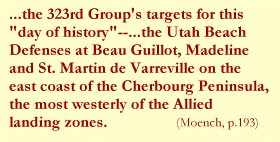 easy to find and should be a milk run, we said...if the weather. The weather, the one thing all the might of the Allies could not win nor could their money buy...the one ?, weather, hung over us, God's way of showing us that no matter how great and powerful we were we must still depend on him for success. (We later learned through the papers that General Eisenhower asked the weatherman for 60 hours of accurately predicted weather and also that the zero hour was postponed for twenty-four hours because of weather..)
easy to find and should be a milk run, we said...if the weather. The weather, the one thing all the might of the Allies could not win nor could their money buy...the one ?, weather, hung over us, God's way of showing us that no matter how great and powerful we were we must still depend on him for success. (We later learned through the papers that General Eisenhower asked the weatherman for 60 hours of accurately predicted weather and also that the zero hour was postponed for twenty-four hours because of weather..)
To get back to the meeting, we were told while studying our targets that paratroops would be dropped in certain areas the night before D.Day. As we left the building a few minutes after our target study we could feel something in the air. All afternoon there was something in the air. Men said nothing but you could see it in their eyes. Those who were not at the meeting knew something of great importance was said behind those doors but they asked no questions.

Later on in the afternoon we noticed the men working on the ships painting black and white stripes on the under surfaces of the wings and fuselage. The loading list went up on the bulletin board in the squadron:
BOX II LEAD FLIGHT
MAJ. SATTERWHITE
HIGH FLIGHT SECOND BOX
CAPT. ENDERTON
LOW FLIGHT SECOND BOX
CAPT. NEELLY
Then we knew D.Day was to be the sixth of June.
The bar was closed that evening of the fifth and our operations officer, then Capt. Sloane, said at a sqdn. meeting that afternoon that there was to be a 12:30 briefing the next morning.
August 28 — France
I didn't want to forget a thing that happened during that twenty-four hours, from 1600 hours June 5th; till 1600 hours June 6th, and everything that I did and that others said and did was engraved in my memory. I remember Chuck and Mac working for hours on the P.D.I. in 961 which we were to fly the following morning. I remember getting a hair cut and while I was sitting in the chair I heard the strains of Swanee River coming from the lounge in the club. I remember trying to sleep and hearing voices from both inside and outside the barracks. The Colonel had said get plenty of sleep but who could sleep. I remember how King and some of the boys played cards until briefing time and I remember seeing a little prayer in everyone's eyes: "Please may the weather be good": it was a prayer that I prayed inside more than once that night.
At last it was twelve-thirty and we rose and went to chow. Some of the men were carrying guns and excitement ran high. We went into the briefing room and the first unnatural thing we all noticed was the presence of War Correspondents.
The Colonel (Wood) finally made things official when he stood before the group and in his usual Texas drawl said, "Gentlemen, this morning we are attacking targets of military importance on the east [5] coast of the Cherbourg peninsula and our operations will be in direct support of the Invasion, and you can make all the noise you want now." Of course there was a
 roar from all seats.
roar from all seats.
Colonel Wood spoke again when the noise died away. "We must hit our target in a three minute period from 0600-0603, and some 2 or 3 minutes after we smash our targets some 300 thousand good ole American boys just like all of us are going in on the beaches down there. If you bombardiers ever hit a target in your career today is the day to do it and I know you will." He later said that we were supporting Gen. Omar Bradley's First Army.
The briefing was carried out as usual; we were to take off before dawn, assemble in flights and proceed to a rally point near Dover. Colonel Wilcox was leading the show with Maj. Helms and Capt. Silk. Chuck had a flight and we had to get our flight to the join-up on time. The weather was not too good but again it wasn't too bad either.
All lead ships were carrying D.8 bomb-sites along in case weather forced us to bomb at low altitudes.
As for fighter cover, "Well," said the Colonel, "in the target area this morning there will be some 1500 Forts and Liberators, 800 Marauders and Havocs and Mitchells and 4,000 fighters covering the area from the surface to 35,000 ft. I remembered this later when I heard what Eisenhower promised the landing parties, "If you see a plane it's ours."
 We went to ships and things looked dark. Col. Brier told us we were to drop down as low as 2,000 ft. if necessary: we must hit the target at all costs.
We went to ships and things looked dark. Col. Brier told us we were to drop down as low as 2,000 ft. if necessary: we must hit the target at all costs.
As Chuck gave her the needle and we started down the runway you couldn't see for the rain that beat against the wind shield. We got our six ships together and to the rally point, some 10,000 feet above the White Cliffs of Dover, on time.
We left the coast at Silsey Bill and we could see that we were going to make a let down in order to get below the cloud cover. Halfway across we were at 5000 feet and no Marauder had struck against the enemy below 8,000' since the first and second disastrous raid of the 322nd a year before.
Also at the halfway mark in the channel we could see gun flashes from the French shore and from Battle wagons on the surface.
We were about to cross the I.P. at Pt. De Barfleur when the Germans threw up a barrage of light flak and Chuck pulled out left in a violent evasive move. A P-51 fighter at our altitude rolled over and dove on the flak outfit giving them Hell with his guns. At this time as if enough wasn't happening a Liberator blew up over the target and went down in a ball of flame. We made our bomb run without flak and dropped our load on the beach. As we pulled off the target we could see parachutes and gliders spread over some areas of the peninsula. We encountered some more light flak as we crossed the center of the peninsula, but our evasive action was good. We came through without a scratch but I know I lost ten years of my life in those few minutes.
That afternoon we lost Stack and Seagraves. We believe all escaped from the ship except the pilot, Paul Stack of Richmond, Texas. [6]
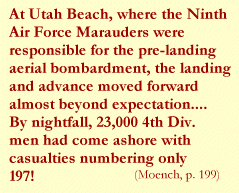 |
August 29 — France
 In those days just following D-day there was quite a let down feeling. During this time we had expected to fly more than we ever had before but actually we flew far less. It was also during this period that the Hun started using his flying bombs on London and Southern England. The X Targets that we had pounded since last November ceased to be targets of military nature and became flying bomb installations. The R.A.F. Bomber Command, heretofore a night ops. outfit became a daylight striking force and went into Pas De Calais to destroy the bomb sites that were bombing their homeland.
In those days just following D-day there was quite a let down feeling. During this time we had expected to fly more than we ever had before but actually we flew far less. It was also during this period that the Hun started using his flying bombs on London and Southern England. The X Targets that we had pounded since last November ceased to be targets of military nature and became flying bomb installations. The R.A.F. Bomber Command, heretofore a night ops. outfit became a daylight striking force and went into Pas De Calais to destroy the bomb sites that were bombing their homeland.
I had anxious moments on leave in London when these bombs fell close to my hotel.
To get back to operations: on June 7th I was with Chuck flying deputy II Box under Sloane. We were to attack railyards at Avrances. We were unable to bomb because of low clouds. This was 53 missions for me.
It was June 11 before I flew again, again with Chuck (High Flight) to attack Lorigny Railyards: did not drop-weather. #54.
On June 12 I made my 55th raid. I was with Chuck leading 18 ships. We attacked a bridge near Dreux. Mac sent home a bombload and got a few direct hits in the target area.
On June 13 we were honored and thrilled, too, when Generals Arnold and Marshall visited our field and talked to a group of the lead teams for awhile. General Anderson spoke to our boss about the work we had been doing and about how he would like to send us home for rest and I believe it was through these talks that the new system for sending men home came about.
On June 15th I was on #56. An easy one. We were dropping window for our bombers near Valognes.
June 17th. With Chuck again leading 18 to a forrest fuel dump just west of Paris. Encountered heavy flak on the way out near Le Havre.
On June 23rd #58 with Chuck leading 18 to a no-ball (Bomb site) near Frévant. We aborted at Furnes, Belgium when our little friends failed to show up, a situation that we seldom had to deal with.

 On July 18th I was with Major Sloane leading second 18 to bomb a troop concentration near Caen. We encountered heavy flak on the turn away from the target and lost our right engine. I thought we had had it, but Sloane did a beautiful job in bringing us home on our one good engine and we landed at Ford. One of the boys stayed on our wing all the way back just in case we had to go into the drink. It gave everyone in our ship a sense of security to see the white-tailed Marauder flying with us ready to give air-sea rescue our position if anything should have happened over the Channel. The English were prepared to give us all aid when we reached Ford Airdrome on the South coast of the island.
On July 18th I was with Major Sloane leading second 18 to bomb a troop concentration near Caen. We encountered heavy flak on the turn away from the target and lost our right engine. I thought we had had it, but Sloane did a beautiful job in bringing us home on our one good engine and we landed at Ford. One of the boys stayed on our wing all the way back just in case we had to go into the drink. It gave everyone in our ship a sense of security to see the white-tailed Marauder flying with us ready to give air-sea rescue our position if anything should have happened over the Channel. The English were prepared to give us all aid when we reached Ford Airdrome on the South coast of the island.
On July 30 I made sortie #60 with Sloane again leading the group on a P.F.F. (Pathfinder) mission to St. Lo, France. No
 incidents. (First mission from Beaulieu.)
incidents. (First mission from Beaulieu.)
On July 31 I was with Major Satterwhite leading the group to a bridge near Rouen. It was my 61st sortie and it presented the most difficult navigation problem I ever encountered (no incidents except flak at target).
On August 6th I made #62 and it was a night mission to an island near St. Malo. Considerable light flak at the target and a very black night but we came through with success. Capt. Kaiser Bombing, Major Satterwhite doing the flying. [7]
Display index of mission maps in a new window
[1] Sadly, Billy never did complete his story of the crossing.
[2] There is some minor confusion between "Mac" and "Mick" in the journal. In the story of the Atlantic crossing "Mac" is certainly Charles W. McKenna, a pilot and very good friend with whom Billy trained in Florida and remained in contact after the war. This is confirmed by McKenna's name on the "Confidential Pass" which is reproduced as page 61 in the journal. But once he begins the descriptions of his bombing missions, "Mac" refers to McAdam, a bombardier and frequent crewmate. There are two types of evidence which confirm this conclusion: on D-Day, according to Moench, pp.468-69, J.R. McAdam is listed as having flown with Billy in the 455th, whereas C.W. McKenna is listed in another Squadron, the 454th; also, Billy mentions in a letter to June that "Mick" is in a different squadron. The few times McKenna is mentioned after Billy began his missions he is referred to as "Mick," as he is exclusively in his letters home to June. So I am not sure why he called him "Mac" early in the Journal.
[3] The word in the journal is almost certainly written as "bigotted" but I am unfamiliar with a use of that word that would make sense here; "billeted" might have been intended.
[4] Of course, "Normandy" is what we remember as the location of D-Day, but you can understand Billy's putting forward of "Cherbourg," since their targets were on a peninsula near this Channel port. It's likely he didn't know where else there would be action, or how far up or down the coast the invasion would be happening; for all he knew, that peninsula was the extent of the territory being targeted. See a map showing where Billy's target was (Mission #52, the red line on the map, is D-Day.)
[5] Billy wrote "west" in the journal, an obvious error, since the Normandy landings were on the east coast of the peninsula. Moench, p. 195, has a discussion of the specific D-Day targets of the 323rd Group.
[6] A general video review of D-Day preparations and operations is available from the National Archives, a newsreel film that includes German footage showing the shore defenses that had to be overcome by the Allies. (If the link to this video does not display it, try searching for the video using Google or look for it here.) According to Moench's listing of D-Day crews, the other men flying this mission with Billy, in addition to Enderton and McAdam, were Sergeants J. A. Ehalt (Engineer), R. L. Schaffert (Radioman), W. R. Hansen (tail-gunner).
[7] This is where the Journal ends. We are fairly confident that subsequent pages are not merely missing, since (as you can see from the PDF copy of the Journal) these last words are not at the bottom of a page. Click here to see pages from the little notebook giving at least the bare facts about Billy's final 4 missions, as well as my speculation as to why the Journal ends so abruptly.
Forward to Final Missions – Demobilization |